610 Search Results for visual support
June 14, 2012
by Robin Parker -

Father’s Day is almost here. We love celebrating fathers and/or the positive male role model in our students lives. The reason we celebrate a variety of ‘father figures’ is that we want to include ALL of our students. So we celebrate grandfathers, uncles, godfathers, husbands, brothers, or any other male the child feels represents a ‘father’ figure. Speech-language pathologists tend to love holidays and art projects. Communication and language is learned in real (authentic) activities. So we found some great Father’s Day Crafts that we are using to facilitate communication/language AND to give ‘dads’ a great home-made gift. Remember though with a little AAC training, Anything we can do, families can do better and more often at home… Dad Tie Snack Jar Candy Bar Letter Tie Wreath Photo Collages Possible Goals (but limitless): requesting with adjectives– ‘want blue crayon’; ‘can I have striped tie?’; ‘need wood glue’ commenting– ‘pretty’; ‘that’s... [Read More...]
May 26, 2012
by Carole Zangari -
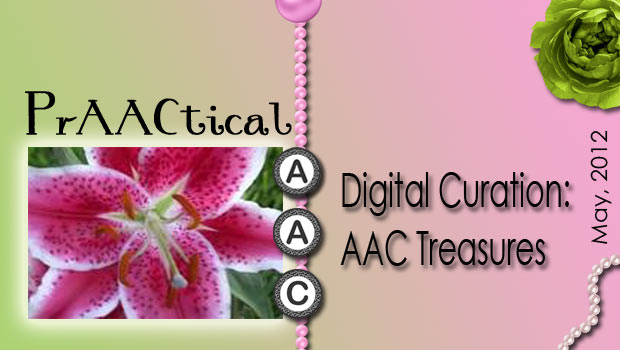
– A curator? Who, me? When a colleague first suggested that the online things we were sharing were part of the digital curation trend, I didn’t quite see it. Yes, I was always on the hunt for sites with quality AAC-related content. Yes, I sifted through those finds carefully to figure out which to keep, which to share, and how to organize it all so that I could actually find it when I needed it. But a curator?! Images of quiet basement rooms and dusty shelves came to mind…not quite the realm of my day-to-day experience. – On closer inspection, though, I began to see what my colleague was saying. Because I teach so many AAC graduate classes fully online, I am always trying to figure out new ways to use technology to get student SLPs engaged and passionate about AAC. It’s been exciting exploring the new web tools over... [Read More...]
May 24, 2012
by Robin Parker -
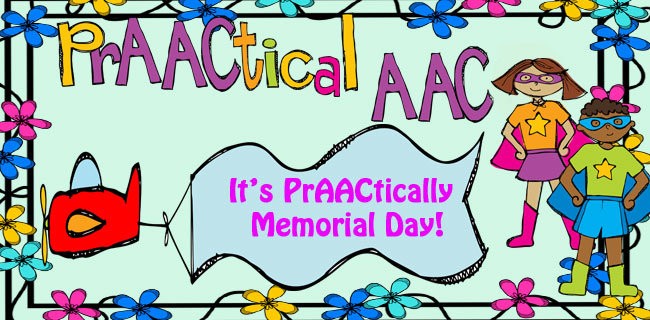
Memorial Day Weekend is big for us. We remember, appreciate, and honor the people who have protected our freedoms. We both have annual relaxing weekends planned. As we started to get ready, though, we started looking for Memorial Day AAC materials. It was surprising to see that there was not much to be found. We found some gluten-casein free Memorial Day recipes, which are great, but what about symbols to go with the recipes or symbols to explain the holiday and what about AAC language activities for the typical long weekend or trip? Not much…. So as we began preparing for our own weekends, these are some of the things we have done or are doing for PrAACtical AAC at home and on our mini-vacations: – Before We Leave Create a personal participation story (modified social story) so ALL the children can SEE the language for the trip. Here’s something that... [Read More...]
May 14, 2012
by Carole Zangari -
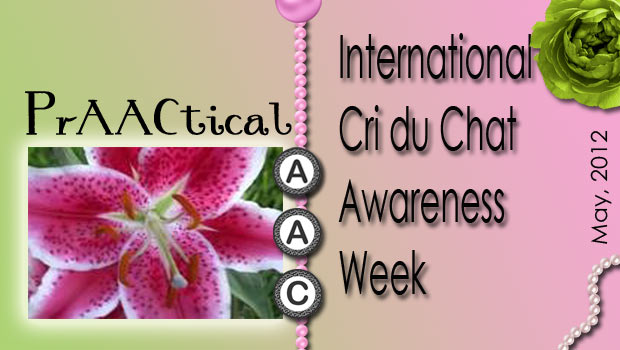
– Today’s post is in honor of the first ever International Cri du Chat Awareness Week and the lovely young lady pictured here (as well as in the brochure linked below). – Cri Du Chat Syndrome (CdCS, also called Lejeune’s syndrome and 5p deletion) is a low incidence genetic disorder caused by a deletion on the short arm of chromosome 5 (5p-). Most children with CCS experience general developmental and communication delays, some of which are quite significant. They tend to have strengths in receptive language. Their speech is often marked by frequent articulation errors, small phonetic inventories, and restricted syllable shapes. Many infants and children with CdCS also have feeding and swallowing difficulties. Children with CdCS have a higher co-occurrence of cleft lip/palate. – 1. 5p- Society (US) and the Annual Conference: Positive Attitude, Reaching New Heights (July, 26-29 in Denver, CO). This group also has a network of... [Read More...]
April 11, 2012
by Carole Zangari -
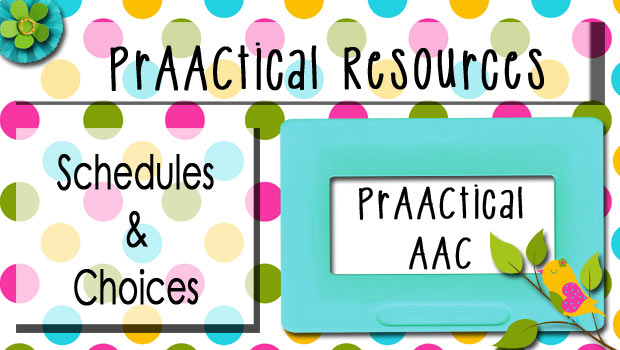
– If you follow our blog, you know that last month we had lots to say on making, teaching, and using Visual Schedules. We ran out of time before we could discuss a question that comes up a lot in our own clinical practice. What role does choice-making play in visual schedules? Here are some of the things we think about when we consider this for the schedules we make and use. We all like to have some say in what we do. Giving the learner an opportunity to make choices in a schedule makes sense when personal autonomy is a priority. Allowing the learner to choose which activities to place on the schedule supports personal autonomy: Having control over what happens in our lives is a big part of happiness for most people. – Here’s how we might do that with a visual schedule for a therapy session. 1.Select... [Read More...]
April 1, 2012
by Carole Zangari -
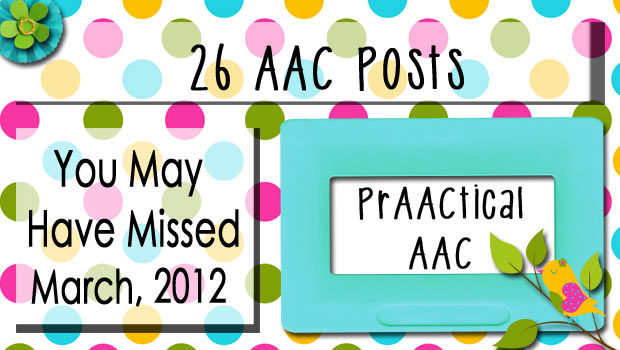
If March was as busy for you as it was for us, then you may have missed some of these posts. Grading exams, meeting with students, clinical paperwork, grant-writing, teaching, travel, etc. Know wonder we’re tired! Enjoy this bit of catch-up. – The Fives 5 Great Resources for Helping Individuals with Vision and Hearing Loss AAC on the Go: 5 Tips for Traveling with AAC Tech it Up’- 5 Visual Schedule Apps 5 Resources for AAC Data Collection 5 Tips to Make AAC Assessments Run Smoothly 5 References to Support AAC Use – PrAACtical Thinking 1. The Secret to Succeeding At Anything 2. National Quilting Day & Employment 3. AAC and March Madness 4. Games are More Than Fun… Gaming for ALL 5. Hearing the Knock 6. HijAACked! AAC & Anti-Bullying with Stand Tall, Mary Lou Melon! 7. Emergencies and Resources to Help 8. Random Acts of Kindness 9. Do... [Read More...]
February 3, 2012
by Robin Parker -
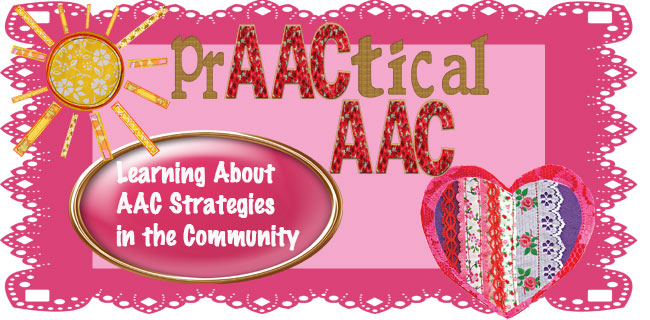
How we integrated AAC strategies into a community event… The name of our website is PrAACtical AAC. We continue to look for ways to make AAC strategies fit praAACtically into ALL activities. We are extremely proud to be part of the Dan Marino Foundation WalkAbout Autism, which is a large South Florida Community Event. The Walkabout helps raise money services for individuals with autism and other developmental disabilities and their families. It also promotes a sense of community collaboration and awareness about autism spectrum disorder and developmental disabilities. We are including this information about the WalkAbout not as a plea for money (although read about the WalkAbout and donate if you are so inclined), but instead to tell you how we are incorporating AAC into community events. This past weekend was the 2nd WalkAbout Autism. It was a truly amazing event and day! There was great music and bounce houses,... [Read More...]
January 23, 2012
by Robin Parker -

AAC & The Art of the Unconventional Conversation, Carole’s post from Saturday, recounts a young girl who some people might have thought was not ready for AAC. It reminds me a young man I know, Michael. I met Michael when he was 14, after he was discharged from all of his communication intervention or I should say his speech-language therapy sessions. He was discharged at school because when he moved from his autism classroom in middle school to a high school classroom for children with varying exceptionalities, it was ‘felt’ that he did not need it anymore. He had not made ‘progress’ in his speech and language goals, he did not talk, he did not consistently identify objects, and he did not essentially do a lot of things. He was discharged from his private therapy as he was not making progress in a lot of goals there either. Everyone... [Read More...]
January 14, 2012
by Carole Zangari -
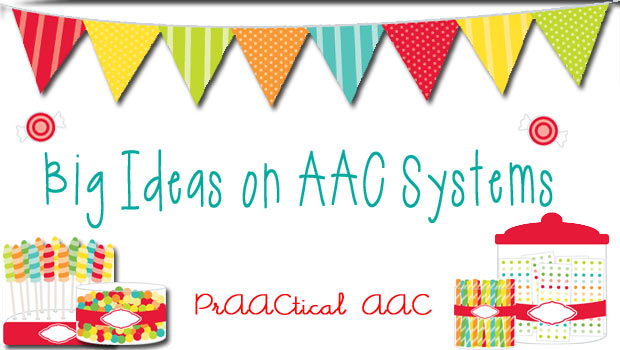
I had some great conversations with families this month about AAC and how to effectively translate strategies from therapy and school to a home environment. Although their children were all different ages, had various disabilities, and used a diverse set of AAC tools, there were a couple of common elements in those conversations.One thing that played a central role was this question: What IS an AAC system? We all know the textbook definition of AAC and that it refers to a set of tools, techniques, and strategies used to enhance the communication of people with significant language difficulties. We know that AAC is often subdivided into unaided communication (including gestures, signs, movement, vocalization, etc) and aided communication (such as communication books, speech generating devices [SGDs], and choice boards).But the general case is only helpful if you’re in AAC class or studying for the PRAXIS. In clinical practice, we need to... [Read More...]
January 6, 2012
by Robin Parker -
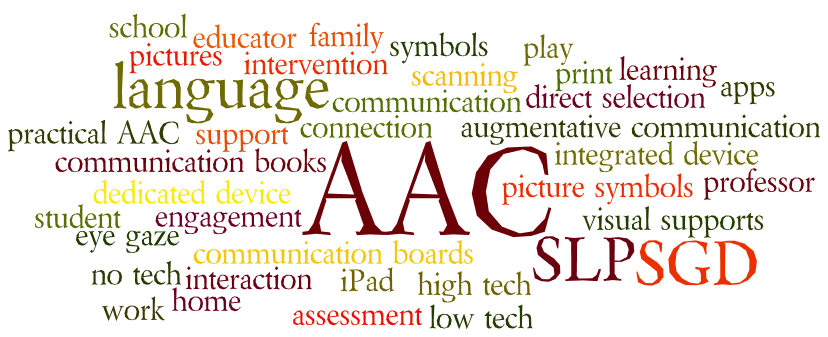
We know that ALL people communicate. However, when someone has communication challenges, their signals may not always be obvious or conventional. Here is our Quick Step Guide to getting to know about someone’s specific communication. Using these steps will help facilitate spontaneous communication and move communication along the continuum of conventionality and symbolism. 1. Observe: What are they doing that is potentially communicative? Look for clues in behaviors. Consider proximity, persistence, expressions, repetition, intensity, or anything else that might expresses a message. More ideas from the National Consortium on Deaf-Blindness. Great information that is applicable to a wide range of early communicators. Don’t rule this out until you’ve looked at it. 2. Interpret: What does that behavior mean? Think about what would they ‘say’ if there was no communication problem. It can be a positive message (‘I want that’, ‘oh come on pretty please’) or a negative message... [Read More...]









